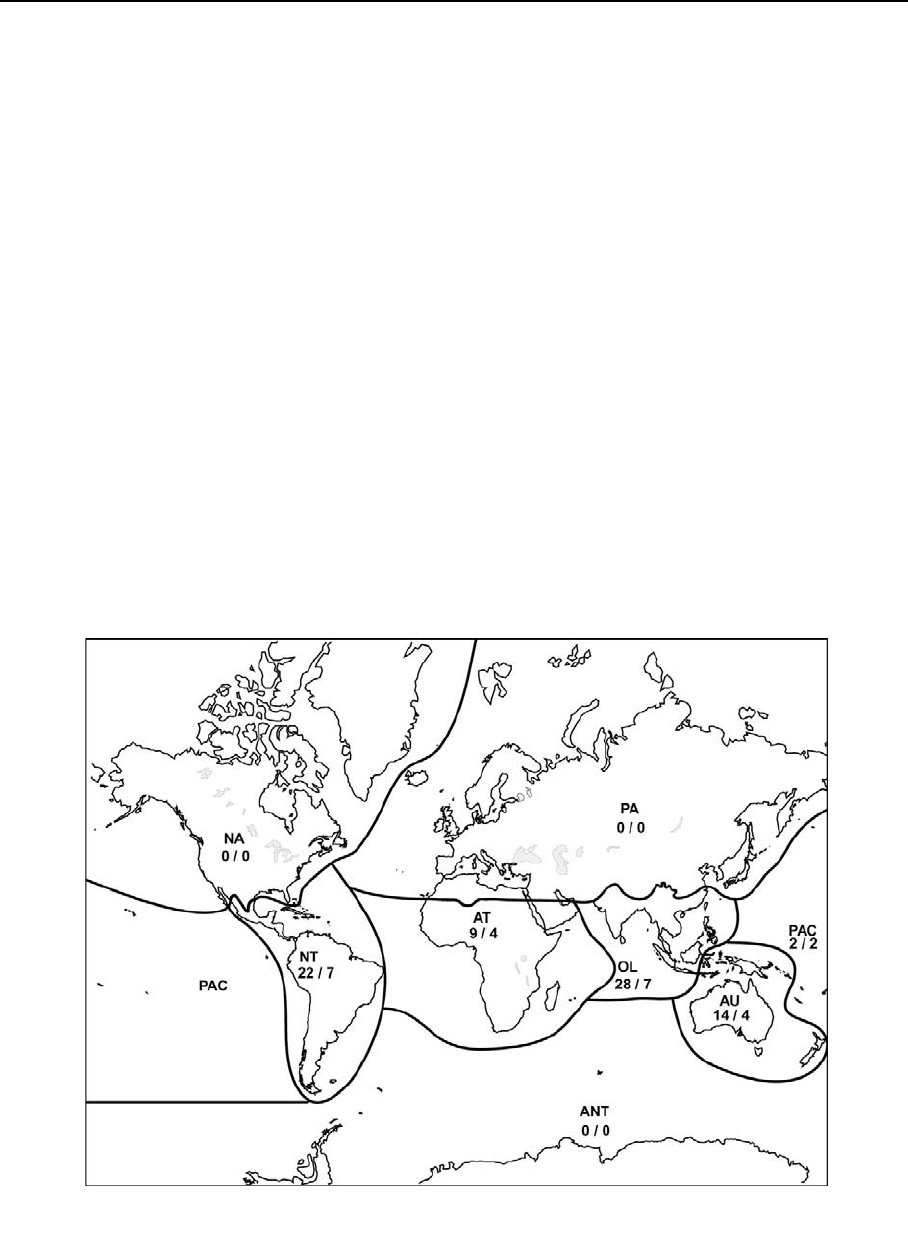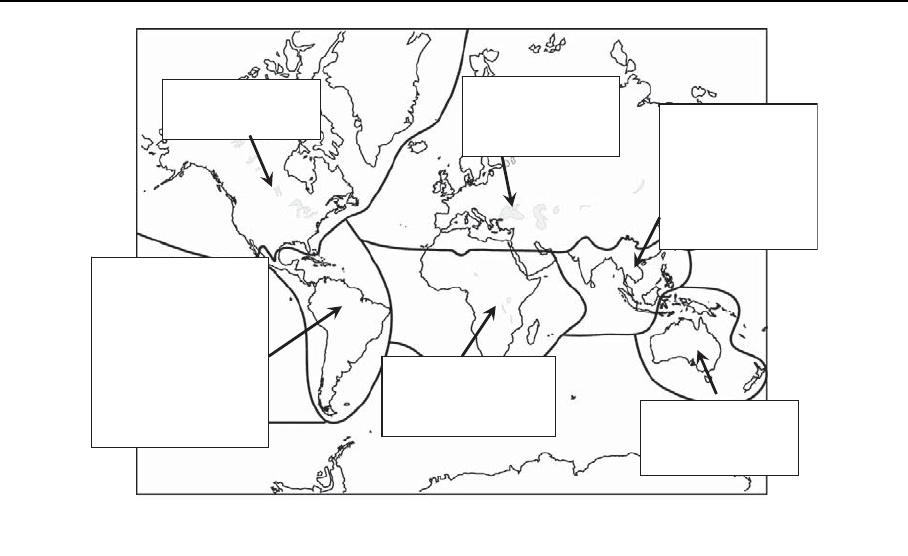Balian E.V., L?v?que C., Segers H., Martens K. (Eds.) Freshwater Animal Diversity Assessment
Подождите немного. Документ загружается.


the Greater Antilles and five in mainland Central
America) are semi-aquatic, representing four inde-
pendent derivations of this lifestyle. Several species
are capable of running on the water surface, but
lack specialized toe fringes. The tropidurid lizard
Uranoscodon superciliosus, likewise, can run on
water and feeds chiefly on invertebrates in the flotsam
at the water’s edge. Many species of gymnophthal-
mids of the genera Neusticurus and Potamites are
also semi-aquatic and are usually associated with
small streams. Several large teiid lizards of South
America are also typically restricted to water courses.
These include Crocodilurus amazonicus and two
species of Dracaena. Members of the latter genus
forage underwater, while walking on the bottom and
are predators on snails. Other Neotro pical lizards,
including the iguanid Iguana iguana and the teiid
Tupinambis teguixin, are often associated with fresh-
water habitats, but are not restrict ed to them.
Oriental region
This region contains the most species of semi-
aquatic lizards. The majority of species are in the
scincid genus Tropidophorus. Many of the species
for which data are available live alon g streambeds
and are the ecological equivalents of the Neotrop-
ical Neusticurus and Potamites. The Vietnamese
skink Sphenomorphus cryptotis is also restricted to
watercourses and has a laterally compressed tail.
The agamid Physignathus cocincinus, as well as all
species of Hydrosaurus are semi-aquatic and the
latter possess toe fringes like those of Basiliscus.
Table 2 Global distribution of freshwater lizard genera by biogeographic region
GN: genus Number PA NA NT AT OL AU PAC ANT World aquatic
Lizards
Agamidae 2 2 2
Corytophanidae 1 1
Gerrhosauridae 1 1
Gymnophthalmidae 2 2
Lanthanotidae 1 1
Polychrotidae 1 1
Scincidae 2 2 1 1 6
Teiidae 2 2
Tropiduridae 1 1
Varanidae 1 1 1 1 1
Xenosauridae 1 1
Total 0 0 7 4 7 4 2 0 19
Note that totals may be lower than the sum of all cells because some genera are shared between regions
PA: Palaearctic; NA: Nearctic; NT: Neotropical; AT: Afrotropical; OL: Oriental; AU: Australasian; PAC: Pacific Oceanic Islands;
ANT: Antarctic
Fig. 1 Endangered
freshwater xenosaurid
lizard, Shinisaurus
crocodilurus, from Yen Tu
Nature Reserve, Quang
Ninh Province, Northeast
Vietnam with body
immersed in pool. Photo
courtesy of Le Khac Quyet/
FFI Vietnam
Hydrobiologia (2008) 595:581–586 583
123

One species, H. amboinensis, extends into the
Australasian region as far as New Guinea. Varanus
salvator is the largest aquatic lizard, reaching total
lengths of more than 3.0 m. It uses a broad range
of aquatic habitats and may be found in brackish or
even salt water, as well as freshwater. The Oriental
fauna also includes two highly distinctive and
phylogenetically isolated taxa, Shinisaurus and
Lanthanotus. Shinisaurus crocodilurus (Fig. 1) is
distributed in China and Vietnam and is amo ng the
most aquatic of lizards. The b iology of Lanthanotus
is poorly known, but its diet and limited natural
history observations indicate that it is both fossorial
and semi-aquatic.
Australasian region
Australasian freshwater lizards occur in the Agami-
dae, Scincidae, and Varanidae. The agamid
Physignathus lesueurii is at least semi-aquatic as
are four members of the Australian lygosomine skink
genus Eulamprus (E. quoyii, E. leuraensis,
E. kosciuskoi, E. tympanum). Three Australian spe-
cies of Varanus (V. mertensi, V. mitchelli,
V. semiremex) are typically semi-aquatic as are some
members of the Indo-Australian V. indicus complex
(V. caerulivirens, V. cerambonensis, V. jobiensis,
V. melinus; ecology unknown in some other recently
described species) although the degree of reliance on
freshwater varies significantly among these species.
One primarily Oriental species, V. salvator, extends
into Australasia in the region of Maluku, Indonesia.
Oceanic islands Pacific
Another member of the Varanus indicus complex,
V. juxtindicus of Rennell Island in the Solomons, is
also semi-aquatic and a single New Caledonian skink,
Lioscincus steindachneri, is strongly associated with
stream courses, particularly as juveniles.
Antarctica
No lizards of any kind occur in Antarctica.
Fig. 2 Continental distribution of freshwater lizards. PA—Palaearctic; NA—Nearctic; NT—Neotropical; AT—Afrotropical ; OL—
Oriental; AU—Australasian; PAC—Pacific Oceanic Islands; ANT—Antarctic
584 Hydrobiologia (2008) 595:581–586
123

A total of 73 lizard species, or slightly less than
1.5% of all currently known taxa, is strongly
associated with freshwater habitats (see Table 1).
No lizard is known from the Antarctic Region and no
freshwater lizards have been recorded from either the
Nearctic or Palearctic regions. Aqua tic lizards are
most speciose in the tropics, particularly in associa-
tion with humid forest regions of Central and South
America, Southe ast Asia, and the Indo-Australian
Archipelago (Fig. 2, Tables 1, 2). Semi-aquatic hab-
its have evolved in many unrelated groups of lizards
and are typically not associated with highly special-
ized morphologies. However, most species that run
on the water surface are members of the Iguania, a
large clade of diurnal, visually oriented, ambush
predators, whereas those lizards that regularly swim
are members of a group of chemosensory active
foragers—the Autarchoglossa. The fundamental dif-
ferences between these two groups in activity,
foraging mode, and dominant sensory modalities
have u ndoubtedly contributed to their alternative
aquatic adaptations, as well as many other ecological
differences (Vitt et al. 2003).
Human related issues
Most lizards are too small to be consumed or otherwise
used commercially by humans. However, larger
lizards, including species of Varanus, Dracaena and
Crocodilurus are harvested for their skins and may be
regularly eaten by people. Harvesting for the skin trade
is especially high (>500,000/annum) for the two semi-
aquatic African Varanus species (de Buffre
´
nil 1993)
and for V. salvator (Luxmoore & Groombridge 1990).
Shinisaurus has been negatively impacted by defores-
tation and is becoming rare within its range (Le Khac
Quyet & Ziegler 2003). All aquatic species of Varanus,
Shinisaurus, Dracaena and Crocodilurus are CITES
Appendix II listed.
References
Avila-Pires, T. C. S., 1995. Lizards of Brazilian Amazonia
(Reptilia: Squamata). Zoologische Verhandelingen 299:
1–706.
Bedford, G. S. & K. A. Christian, 1996. Tail morphology
related to habitat of varanid lizards and some other
reptiles. Amphibia–Reptilia 17: 131–140.
Beebe, W., 1945. Field notes on the lizards of Kartabo, British
Guiana and Caripito, Venezuela. Part 3. Teiidae, Amphi-
sbaenidae and Scincidae. Zoologica (New York) 30: 7–31.
Blanc, C. P., 1967. Notes sur les Gerrhosaurinae de Mada-
gascar, I. - Observations sur Zonosaurus maximus,
Boulenger, 1896. Annales de l’Universite
´
de Madagascar
(Sciences) 5: 107–116.
Bo
¨
hme, W., A. Schmitz & T. Ziegler, 2000. A review of the
West African skink genus Cophoscincopus Mertens
(Reptilia: Scincidae: Lygosominae): resurrection of C.
simulans (Vaillant, 1884) and description of a new spe-
cies. Revue suisse de Zoologie 107: 777–791.
Daniels, C. B., 1987. Aspects of the aquatic feeding ecology of
the riparian skink Sphenomorphus quoyii. Australian
Journal of Zoology 35: 253–258.
Darevsky, I. S., N. L. Orlov & TC Ho, 2004. Two new lyg-
osomine skinks of the genus Sphenomorphus Fitzinger,
1843 (Sauria, Scincidae) from northern Vietnam. Russian
Journal of Herpetology 11: 111–120.
de Buffre
´
nil, V., 1993. Les Varans Africains (Varanus niloticus
et Varanus exanthematicus). Donne
´
es de Synthe
`
se sur leur
Biologie et leur Exploitation. Secre
´
tariat CITES, Gene
`
ve.
Doan, T. M. & T. A. Castoe, 2005. Phylogenetic taxonomy of
the Cercosaurini (Squamata: Gymnophthalmidae), with
new genera for species of Neusticurus and Proctoporus.
Zoological Journal of the Linnean Society 143: 405–416.
Glaw, F. & M. Vences, 1994. A Fieldguide to the Amphibians
and Reptiles of Madagascar, second edition. M. Vences &
F. Glaw Verlags GbR, Ko
¨
ln.
Greer, A. E., 1989. The Biology & Evolution of Australian
Lizards. Surrey Beatty & Sons Pty. Ltd., Chipping
Norton.
Honda, M., H. Ota, R. W. Murphy & T. Hikida, 2006.
Phylogeny and biogeography of water skinks of the genus
Tropidophorus (Reptilia: Scincidae): A molecular
approach. Zoologica Scripta 35: 85–95.
Howland, J. M., L. J. Vitt & P. T. Lopez, 1990. Life of the
edge: The ecology and life history of the tropidurine ig-
uanid lizard Uranoscodon superciliosum. Canadian
Journal of Zoology 68: 1366–1373.
Le Khac Q. & T. Ziegler, 2003. First record of the Chinese
crocodile lizard from outside of China: Report on a pop-
ulation of Shinisaurus crocodilurus Ahl, 1930 from north-
eastern Vietnam. Hamadryad 27: 193–199.
Leal, M., A. K. Knox & J. B. Losos, 2002. Lack of conver-
gence in aquatic Anolis lizards. Evolution 56: 785–791.
Lee, M. S., 2005. Squamate phylogeny, taxon sampling, and
data congruence. Organisms, Diversity & Evolution 5:
25–45.
Luke, C., 1986. Convergent evolution of lizard toe fringes.
Biological Journal of the Linnean Society 27: 1–16.
Luxmoore, R. & B. Groombridge, 1990. Asian Monitor
Lizards: A Review of Distribution, Status, Exploitaion
and Trade in Four Selected Species. Secre
´
tariat CITES,
Lausanne.
Ma
¨
gdefrau,
H.,
1987. Zur Situation der Chinesischen Kro-
kodilschwanz-Ho
¨
ckerechse, Shinisaurus crocodilurus
Ahl, 1930. Herpetofauna 51: 6–11.
Pianka, E. R. & L. J. Vitt, 2003. Lizards, Windows to the
Evolution of Diversity. University of California Press,
Berkeley.
Hydrobiologia (2008) 595:581–586 585
123

Shine, R., 1986. Diets and abundances of aquatic and semi-
aquatic reptiles in the Alligator Rivers region. Supervising
Scientist for the Alligator Rivers Region Technical
Memorandum 16: 1–54.
Sprackland, G. B., 1972. A summary of observations of the
earless monitor, Lanthanotus borneensis. Sarawak
Museum Journal 20: 323–327.
Townsend, T. M., A. Larson, E. Louis & J. R. Macey, 2004.
Molecular phylogenetics of Squamata: the position of
snakes, amphisbaenians, and dibamids, and the root of the
squamate tree. Systematic Biology 53: 735–757.
Vitt, L. J. & T. C. S. Avila-Pires, 1998. Ecology of two
sympatric species of Neusticurus (Sauria: Gymno-
phthalmidae) in the western Amazon of Brazil. Copeia
1998: 570–582.
Vitt, L. J., E. R. Pianka, W. E. Cooper Jr. & K. Schwenk, 2003.
History and global ecology of squamate reptiles. The
American Naturalist 162: 44–60.
586 Hydrobiologia (2008) 595:581–586
123

FRESHWATER ANIMAL DIVERSITY ASSESSMENT
Global diversity of crocodiles (Crocodilia, Reptilia)
in freshwater
Samuel Martin
Springer Science+Business Media B.V. 2007
Abstract Living crocodilians include the 24 species
of alligators, caimans, crocodiles and gharials. These
large semi-aquatic ambush predators are ubiquitous
in freshwater ecosystems throughout the world’s
tropics and warm temperate regions. Extant croco-
dilian diversity is low, but the group has a rich fossil
record in every continental deposit. Most populations
suffered from over-hunting and habitat loss during
the twentieth century and even though some species
remain critically endangered others are real success
stories in conservation biology and have become
important economic resources.
Keywords Crocodile Alligator
Gharial Archosauria
Introduction
The living crocodilians belong to the order Crocody-
lia which is now represented by three families: the
Crocodylidae, the Alligatoridae and the Gavialidae
(Brochu, 2003). The 24 species of the group are all-
amphibious and share morphological, anatomical,
and physiological features, which make them more
adapted to water than to land (Lang, 1976).
They all live in tropical and subtropical areas in
various aquatic habitats (forest streams, rivers,
marshes, swamp s, elbow lakes, etc.) and can be
considered as the largest fresh water dwellers. They
can occasionally adapt to salty waters (mangroves or
estuaries) (Dunson, 1982; Mazzotti & Dunson, 1984).
They are nocturnal carnivorous opportunistic preda-
tors, whose diet depends on their developmental
stage, species and potential prey diversity (Magnus-
son et al., 1987). All crocodilian species may be
considered as totally water dependent since they can
only mate in water. Crocodilians appear to be very
important for freshwater ecosystems as they main-
tain, during the dry season waterholes that are used as
reservoir for many arthropods, crustacean, fishes and
amphibians (Gans, 1989; Kushlan, 1974).
Species/generic diversity
With only 24 living species, the order Crocodylia is
the smallest taxonomic group of the class Reptilia.
The three families, Crocodylidae, Alligatoridae and
Gavialidae are quite homogeneous taxa as they
contain between two and four genera.
The highest level of species diversity is to be
found in the genus Crocodylus which gathers 13
species, whereas other genera only display one or two
species.
Guest editors: E. V. Balian, C. Le
´
ve
ˆ
que, H. Segers &
K. Martens
Freshwater Animal Diversity Assessment
S. Martin (&)
La Ferme aux Crocodiles, Pierrelatte 26700, France
e-mail: s.martin@lafermeauxcrocodiles.com
123
Hydrobiologia (2008) 595:587–591
DOI 10.1007/s10750-007-9030-4

The taxo nomic place of Tomistoma schlegelii is
also subject to debate among specialists. It used to be
placed with the subfamily Crocodylinae, whereas
other created the subfamilily Tomistominae. Based
on morphological features and on the latest DNA
studies, we chose to place them together with
Gavialis in the subfamily Gavialinae (Groombridge,
1987; Gatsby & Amato, 1992; Brochu, 2003).
(Tables 1, 2)
Phylogeny and historical processes
Crocodilians belong to the great group of archosaurs
which includes two extinct clades: the pterosaurs and
the dinosaurs (Blake, 1982). The history of the
crocodilians has been well reviewed by Buffetaud
(1982), Taplin (1984), Taplin & Grigg (1989) and
Brochu (2003). The very first crocodilians called
Protosuchians are from the early Jurassic, whereas
the Eusuchians (the modern crocodilians) appeared in
the upper Triassic around 220 Million years ago
under the form of terrestrial carnivores gathered in
the group of Pristichampsines. The eight surviving
genera of crocodilians are only a tiny rest of the past
diversity of the group which has been revealed by at
least 150 fossile genera (Broch u, 2003). The croco-
dilian diversity showed two peaks—one in the early
Eocene and the other one in the early Miocene
(Taplin, 1984; Markewick 1998). These fossils sug-
gest that crocodili omorphs were adapted to terrestrial,
sub-aquatic, and even to marine environment (cf.
Thalattosuchians). Until the end of the Tertiary, the
geographical distribution of the crocodilians was
much broader. The more restricted current distribu-
tion is due to the climatic deterioration, which
narrowed the tropical and subtropical zones (Marke-
wick, 1998).
Present distribution and main areas of endemicity
(Groombridge, 1987; Ross 1998)
Except the two Alligator species which are to some
extend more tolerant to colder temperatures, crocod-
ilians are distributed in inter-tropical wetl ands. As
shown in Table 3, most crocodilians are endemic of a
zoogeographical region. Only three species of the
genus Crocodylus (C. niloticus, C. porosus and C.
siamensis) and a gavialid (Gavialis gangeticus) are
found in two adjacent regions. The range of distri-
bution of crocodilians can be very variable in size.
Some species, such as the Nile crocodile (Crocody lus
niloticus) in Africa, the saltwater crocodile, (Croco-
dylus porosus) in the indopacific region or the
spectacled caiman ( Caiman crocodilus crocodilus)
in South America are widely represented at a
continental level, whereas most species are living in
more restricted areas. This is one of the reasons that
today half of the existing crocodilian species are
considered either as being endangered or threatened
according to the Red List criteria of the World
Conservation Union IUCN. The Chinese alligator
(Alligator sinensis), the Siamese crocodile ( Croco-
dylus siamensis), the Orinoco crocodile (Crocodylus
intermedius) and the Philippine crocodile (Crocody-
lus mindorensis) may be considered as the most
endangered crocodilians species. The first one is only
found in a few spots along the lower part of Yangtze
River with a remaining stronghold in the province of
Anhui in People’s Republic of China, the second one
is restricted to five Asian countries (Cambodia,
Thailand, Vietnam, Indonesia and Laos) with
Table 1 Freshwater crocodilian species in the zoogeographical
regions
PA NA AT NT OL AU PAC ANT World
Alligatoridae 0 1 0 5 1 0 0 0 7
Crocodylidae 2 1 3 4 5 4 0 0 14
Gavialidae 1 0 0 0 2 0 0 0 2
Total 3 2 3 9 8 4 0 0
PA: Palaearctic, NA: Nearctic, NT: Neotropical, AT:
Afrotropical, OL: Oriental, AU: Australasian, PAC: Pacific
Oceanic Islands, ANT: Antarctic
Table 2 Freshwater crocodilian genera in the zoogeographical
regions
PA NA AT NT OL AU PAC ANT World
Alligatoridae 0 1 0 3 1 0 0 0 4
Crocodylidae 1 1 2 1 1 1 0 0 2
Gavialidae 1 0 0 0 2 0 0 0 2
Total 2 2 2 4 4 1 0 0 8
PA: Palaearctic, NA: Nearctic, NT: Neotropical, AT:
Afrotropical, OL: Oriental, AU: Australasian, PAC: Pacific
Oceanic Islands, ANT: Antarctic
588 Hydrobiologia (2008) 595:587–591
123

scattered extremely small populations, the third one is
restricted to the Orinoco water system of Venezuela
and Colombia only and the fourth one is endemic to
the archipelago of Philippines. The reasons for their
being endangered are due to human pressure on
habitat, but inversely linked to the adaptability to
habitat variations. For instance the Nile crocodile is
able to live in diverse aquatic environment s such as
streams, forest rivers, swamps, marshes, lagoons and
even small desert water holes like a few known small
populations lost in the Mauritanian Sahara (Pooley &
Gans, 1976; Shine et al., 2001). This species like
many other Crocodylidae and Alligatoridae are able
to walk long distances on dry land. When necessary
during long periods of drought they are able to
migrate to find new water spots. Other species such as
the mugger crocodile (Crocodylus palustris) will dig
burrows during the dry season to protect themselves
from the sun and wait in the shade the next raining
season (Rao, 1994). Other crocodilian species adapt
at burrowing are Alligator sinensis and Osteolaemus
tetraspis. According to IUCN criteria, out of 24
Table 3 Distribution of the 24 crocodilian species in the eight zoogeographical regions
Family Genus Species Sub species Distribution region Common name, IUCN red
list
Alligatoridae
(4 genera, 7 species)
Alligator A. mississippiensis Nearctic American alligator/LR
A. sinensis Oriental Chinese alligator/CR
Caiman C. crocodilus C.c. apaporiensis, Neotropical Spectacled caı
¨
man/LR
C. c. crocodilus,
C. c. fuscus
C. c. yacare
C. latirostris Neotropical Broad snouted caiman/LR
Melanosuchus M. niger Neotropical Black caiman/LR
Palaeosuchus P. palpebrosus Neotropical Cuvier’s smooth fronted
caiman/LR
P. trigonatus Neotropical Schneider’s smooth
fronted caiman/LR
Crocodylidae
(2 genera, 14
species)
Crocodylus C. acutus Nearctic; Neotropical American crocodile/Vu
C. cataphractus Afrotropical African slender snouted
crocodile/DD
C. intermedius Neotropical Orinoco crocodile/CR
C. johnsoni Australasia Australian freshwater
crocodile/LR
C. mindorensis Oriental Philippines crocodile/CR
C. moreletii Neotropical Morelet’s crocodile/LR
C. novaeguineae Australasia New guinea crocodile/LR
C. niloticus Palearctic, Afrotropical Nile crocodile/LR
C. palustris Palearctic, Oriental Marsh crocodile/LR
C. porosus Oriental, Australasia Estuarine crocodile/LR
C. raninus Oriental Borneo crocodile/DD
C. rhombifer Neotropical Cuban crocodile/EN
C. siamensis Oriental, Australasia Siamese crocodile/CR
Osteolaemus O. tetraspis O. t. tetraspis &
O. t. osborni
Afrotropical African dwarf crocodile/
Vu
Galvialidae
(2 genera,
2 species)
Gavialis G. gangeticus Palearctic, Oriental Gharial/EN
Tomistoma T. schlegelii Oriental False gharial/EN
Four species CR (Critically endangered), three species E (Endangered), 14 species LR (Low risks), two species DD (Data deficiency)
Hydrobiologia (2008) 595:587–591 589
123

crocodilian species, four are critically endangered,
three endangered and two species are considered as
vulnerable (IUCN red list of threatened species,
2004) (Fig. 1).
Human related issues
Humans and crocodilians have been interacting
since the dawn of civilization. Large crocodilians
are potentially dangerous to man as they can prey
on humans. Their populations have been depleted
until the mid 60’ies because the high prices paid for
their hides. In order to limit harvesting of wild
populations, farming and ranching programs have
been set up (Blake, 1982). Today several hundreds
of farms around the world are breeding and raising
crocodilians for leather and meat production (Braza-
itis et al., 1998). Despite these efforts, some wild
crocodilian populations are still depleting due to
competition with humans for habitat and food. Dam
construction on water streams has blocked seas onal
migration of aquatic species when their prey was
going down-stream during the rainy seas on and up-
stream when the water level lowers (Gans, 1989).
The draining of swamps for agricultural purposes
has increased drastically habitat fragmentation and
pollution. On a worldwide scale, the Crocodile
Specialist Group of the I.U.C.N. Species Survival
Commission coordinates crocodilian conservation
programmes. The most successful ones are based
on local community involvement combined with
education (Ross, 1998).
Complete bibliography can be found on: http://
utweb.ut.edu/faculty/mmeers/bcb/index.html
Reliable website: http://www.flmnh.ufl.edu/cnhc/
csl.html
UNC/Species Survival Commission Crocodile
Specialist Group News letter http://www.flmnh.ufl.
edu/natsci/herpetology/ CROCS/CSGnewsletter.htm
References
Blake, D. K., 1982. Crocodile ranching in Zimbabwe. The
Zimbabwe Science News 26: 208–209.
Brazaitis, P., M. E. Watanabe & G. Amato, 1998. Trafic de
Caı
¨
mans. Pour la Science 247: 84–90.
Brochu, C. A., 2003. Phylogenetic approaches toward croco-
dilian history. Annual Revue of Earth Planet Science 31:
357–397.
Buffetaud, E., 1982. The evolution of crocodilians. American
Science 241:124–132.
:AN
sisneippississim rotagillA
sutucasulydocorC
:TA
sutcarhpatacsulydocorC
sucitolinsulydocorC
sipsartetsipsartetsumealoetsO
inrobsosipsartetsumealoetsO
:TN
sirtsoritalnamiaC
sisneiropapasulidocorcnamiaC
,sulidocorcsulidocorcnamiaC
sucsufsulidocorcnamiaC
eracaysulidocorcnamiaC
regin suhcusonaleM
susorbeplap suhcusoealaP
sutanogirt suhcusoealaP
sutucasulydocorC
suidemretni sulydocorC
iiteleromsulydocorC
refibmohr sulydocorC
:LO
sisnenis rotagillA
sisnerodnimsulydocorC
sirtsulapsulydocorC
susoropsulydocorC
suninarsulydocorC
sisnemaissulydocorC
sucitegnagsilaivaG
iilegelhcsamotsimoT
:AP
sucitolinsulydocorC
sirtsulapsulydocorC
sucitegnagsilaivaG
:UA
inotsnhojsulydocorC
eaeniugeavonsulydocorC
susoropsulydocorC
sisnemaissulydocorC
Fig. 1 Distribution of the 24 crocodilian species in the eight zoogeographical regions. PA: Palaearctic, NA: Nearctic, NT:
Neotropical, AT: Afrotropical, OL: Oriental, AU: Australasian, PAC: Pacific Oceanic Islands, ANT: Antarctic
590 Hydrobiologia (2008) 595:587–591
123

Dunson, W. A., 1982. Salinity relations of crocodiles in Florida
Bay. Copeia 2: 374–385.
Gans, C., 1989. Crocodilians in perspective! American Zool-
ogist 29: 1051–1054.
Gatsby, J. & G. D. Amato, 1992. Sequence similarity of 12S
ribosomal segment of mitochondrial DNAs of gharial and
false gharial. Copeia 1992: 241–244.
Groombridge, B., 1987. The distribution and status of world
crocodilians. In Webb, G. J. W., S. C. Manolis & P. J.
Whitehead (eds), Wildlife Management: Crocodiles and
Alligators. Chipping Norton, Australia, Surrey Betty and
Sons Printing in association with the Conservation Com-
mission of the Northern Territory, 9–21.
IUCN Red List of Threatened Specie, 2004. IUCN. Gland.
Switzerland.
Kushlan, A. J., 1974. Observations on the role of the Americain
alligator (Alligator mississippiensis) in the Southern
Florida Wetlands. Copeia 4: 993–996.
Lang, W. J., 1976. Amphibious behavior of Alligator missis-
sippiensis. Science 191: 575–577.
Magnusson, E. W., E. V. Da Silva & A. P. Lima, 1987. Diets of
Amazonian crocodilians. Journal of Herpetology 21: 85–
95.
Markewick, P. J., 1998. Crocodilian diversity in space and
time: the role of climate in paleoecology and its
implication for understanding K/T extinctions. Paleobi-
ology 24: 470–497.
Mazzotti, J. & W. A. Dunson, 1984. Adaptations of Crocodylus
acutus and Alligator for life in saline water. Comparative
Biochemistry and Physiology 79: 641–646.
Pooley, A. C. & C. Gans, 1976. The Nile crocodile. Scientific
American 234: 114–124.
Rao, R. J., 1994. Ecological studies of Indian crocodiles: an
overview. CSG Proceedings, Pattaya, Thailand, 2–6 May
1994. Crocodile Specialist Group, Vol. 1, 259–273.
Ross, J. P. 1998. Crocodiles-Status, Survey and Conservation
Action Plan. International Union for Nature Conservation
Switzerland.
Shine, T., W. Bo
¨
hme, H. Nickel, D. F. Thies & T. Wilms,
2001. Rediscovery of relict populations of the Nile croc-
odile Crocodylus niloticus in South-Eastern Mauritania,
with observations on their natural history. Oryx 35: 260–
262.
Taplin, L., 1984. Evolution and zoogeography of crocodilians:
a new look at an ancient order. In Archer, M. & G.
Clayton (eds), Vertebrate Evolution and Zoogeography in
Australasia. Hesperian Press, Perth, 361–370.
Taplin, L. E. & G. C. Grigg, 1989. Historical zoogeography of
the eusuchian crocodilians: a physiological perspective.
American Zoology 29: 885–901.
Hydrobiologia (2008) 595:587–591 591
123

FRESHWATER ANIMAL DIVERSITY ASSESSMENT
Global diversity of turtles (Chelonii; Reptilia) in freshwater
Roger Bour
Springer Science+Business Media B.V. 2007
Abstract The turtles are an evolutionary ancient
group of tetrapod vertebrates, and their present-day
distribution and diversity reflects the long and complex
history of the taxon. Today, about 250 of the total of 320
species recognized are freshwater turtles; most of these
inhabit tropical and subtropical zones. Diversity hotspots
occur in Southeast North America, regarding Emydidae,
and in the Indo-Malayan region, mostly Geoemydidae
and Trionychidae. Chelidae are predominantly Neotrop-
ical and Australasian, while Pelomedusidae are African.
The majority of genus- and species-level taxa are
regional or even local endemics. A majority of freshwa-
ter turtles are threatened in varying degrees, mostly by
habitat modification and collection.
Keywords Biodiversity Zoogeography
Chelonii Review
Introduction
Turtles or Chelonians (order Chelonii, class Reptilia)
are very ancient tetrapod vertebrates, their first
members being known from Keuper (Triassic) deposits
of ca. 230 M years old. The extant families have a relict
distribution pattern that reflects their long evolutionary
history. Morpho-functional analysis of their fossil
remains, especially their limbs, reveals that the oldest
known Chelonians most likely inhabited swamps or
marshlands, and their present relatives are mostly
freshwater species.
Soon after its emergence (Triassic–Jurassic), the
order split into two groups diagnosed by several
anatomical features, amongst which are the articula-
tion of the cervical vertebrae and bending of the neck.
These groups, namely Pleurodira (neck bending in a
horizontal plane: ‘‘side neck’’) and Cryptodira (neck
bending in a vertical plane, and neck more or less
retractable inside the shell: ‘‘hidden neck’’), are still
present today, although they have different and
unequal areas of occurrence and species richness.
Cryptodira includes freshwater turtles in addition to
marine turtles and terrestrial tortoises, while all
Pleurodira species are more or less completely fresh-
water dependant (Fig. 1).
Reliance of turtles on freshwater is quite variable,
depending on the species, and also on the age for
some species. Roughly, the typical habitat may vary
from large rivers and lakes, sometimes estuaries, to
swamps, marshes, bogs, occasionally brackish waters,
and some species are nearly as terrestrial as true land
tortoises, which, themselves, include a few species
that require a very damp environment. ‘‘Terrestrial’’
freshwater turtles are encountered in both large
Guest editors: E. V. Balian, C. Le
´
ve
ˆ
que, H. Segers &
K. Martens
Freshwater Animal Diversity Assessment
R. Bour (&)
Reptiles et Amphibiens, Syste
´
matique et Evolution,
Muse
´
um national d’Histoire naturelle, 25 rue Cuvier,
Paris 75231, France
e-mail: bour@mnhn.fr
123
Hydrobiologia (2008) 595:593–598
DOI 10.1007/s10750-007-9244-5
